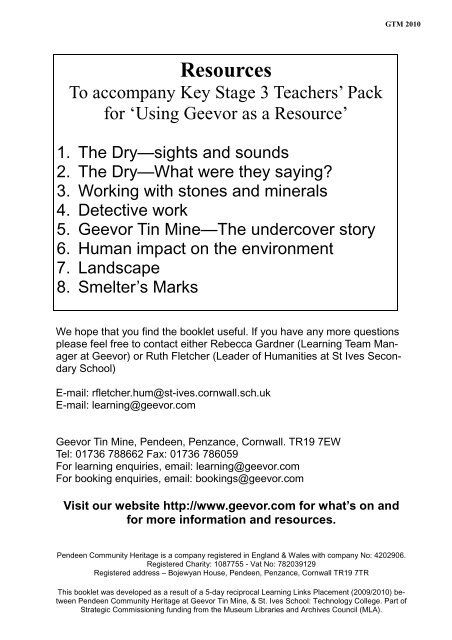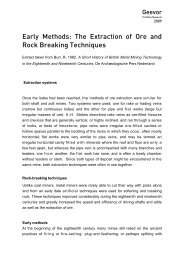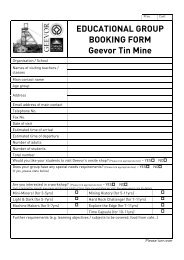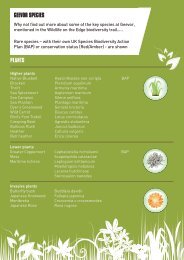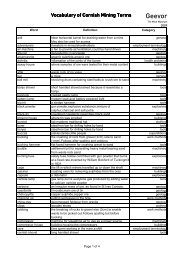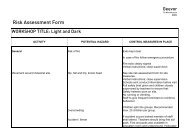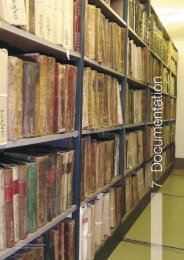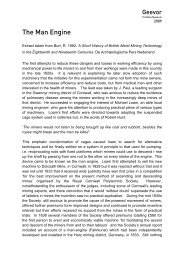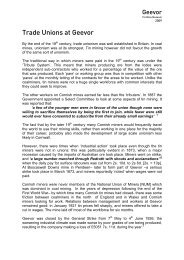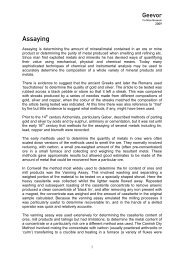Resources to accompany KS3 Teachers ... - Geevor Tin Mine
Resources to accompany KS3 Teachers ... - Geevor Tin Mine
Resources to accompany KS3 Teachers ... - Geevor Tin Mine
You also want an ePaper? Increase the reach of your titles
YUMPU automatically turns print PDFs into web optimized ePapers that Google loves.
GTM 2010<br />
<strong>Resources</strong><br />
To <strong>accompany</strong> Key Stage 3 <strong>Teachers</strong>’ Pack<br />
for ‘Using <strong>Geevor</strong> as a Resource’<br />
1. The Dry—sights and sounds<br />
2. The Dry—What were they saying?<br />
3. Working with s<strong>to</strong>nes and minerals<br />
4. Detective work<br />
5. <strong>Geevor</strong> <strong>Tin</strong> <strong>Mine</strong>—The undercover s<strong>to</strong>ry<br />
6. Human impact on the environment<br />
7. Landscape<br />
8. Smelter’s Marks<br />
We hope that you find the booklet useful. If you have any more questions<br />
please feel free <strong>to</strong> contact either Rebecca Gardner (Learning Team Manager<br />
at <strong>Geevor</strong>) or Ruth Fletcher (Leader of Humanities at St Ives Secondary<br />
School)<br />
E-mail: rfletcher.hum@st-ives.cornwall.sch.uk<br />
E-mail: learning@geevor.com<br />
<strong>Geevor</strong> <strong>Tin</strong> <strong>Mine</strong>, Pendeen, Penzance, Cornwall. TR19 7EW<br />
Tel: 01736 788662 Fax: 01736 786059<br />
For learning enquiries, email: learning@geevor.com<br />
For booking enquiries, email: bookings@geevor.com<br />
Visit our website http://www.geevor.com for what’s on and<br />
for more information and resources.<br />
Pendeen Community Heritage is a company registered in England & Wales with company No: 4202906.<br />
Registered Charity: 1087755 - Vat No: 782039129<br />
Registered address – Bojewyan House, Pendeen, Penzance, Cornwall TR19 7TR<br />
This booklet was developed as a result of a 5-day reciprocal Learning Links Placement (2009/2010) between<br />
Pendeen Community Heritage at <strong>Geevor</strong> <strong>Tin</strong> <strong>Mine</strong>, & St. Ives School: Technology College. Part of<br />
Strategic Commissioning funding from the Museum Libraries and Archives Council (MLA).
Resource 1 GTM 2010<br />
FACTS<br />
The Dry Room<br />
Sights Sounds
Resource 2 GTM 2010
Resource 3<br />
GTM 2010<br />
VARIETIES OF CHALCEDONY<br />
CARNELIAN<br />
TIGERS EYE<br />
AGATE<br />
‘BLOODSTONE’<br />
METAL ORES<br />
CASSITERITE<br />
(TIN ORE)<br />
HEMATITE<br />
(IRON ORE)<br />
GALENA<br />
(LEAD ORE)<br />
CHALCOPYRITE<br />
(COPPER ORE)
Resource 3<br />
GTM 2010<br />
GOLD<br />
METALS<br />
IRON PYRITE<br />
(“FOOL’S GOLD”)<br />
NATIVE COPPER<br />
NATIVE SILVER<br />
VARIETIES OF QUARTZ<br />
AMETHYST<br />
ROSE QUARTZ<br />
ROCK CRYSTAL<br />
AVENTURINE
Resource 3<br />
GTM 2010<br />
VARIETIES OF QUARTZ<br />
SMOKY QUARTZ<br />
CITRINE<br />
WHICH OF THESE MINERALS<br />
CAN YOU FIND<br />
IN THE PANNING<br />
TRAYS???....<br />
QUARTZ<br />
METALS METAL ORES CHALCEDONY<br />
Visit the <strong>Geevor</strong> <strong>Tin</strong> <strong>Mine</strong> website <strong>to</strong> find out more about these metals and minerals<br />
www.geevor.com
GTM 2010<br />
Resource 4<br />
Detective Work<br />
Hard Rock—The S<strong>to</strong>ry of <strong>Tin</strong><br />
As you enter the museum take some time <strong>to</strong> look at the model of the local landscape.<br />
What do you learn about mining and the rich mineral deposits in the<br />
area?<br />
Go <strong>to</strong> your right and have a look at the exhibits on<br />
minerals and ores. Then make your way in<strong>to</strong> the next room and look for the following<br />
information.<br />
What is an alloy?<br />
_______________________________<br />
What two metal ores make the following:<br />
• Bronze = ________________________<br />
• Pewter = ________________________<br />
For how long has tin<br />
and copper been mined<br />
in this area?<br />
_________________<br />
• Brass = _________________________<br />
Find some object in the display cases made of tin and draw them
Resource 4<br />
GTM 2010<br />
Inventiveness<br />
What is one of the waste products of tin<br />
and copper ore?<br />
Sketch the wallpaper pattern that was made of this waste<br />
product<br />
_________________________<br />
What could this be used for?<br />
_________________________________<br />
________________________________<br />
When were tin cans I<br />
invented?<br />
______________<br />
What were goose quills used for in mining?<br />
______________________________________________<br />
What inventions have helped miners at their work over the years?
Resource 4 GTM 2010<br />
A <strong>Mine</strong>r’s Life<br />
What was a Balmaiden? What did they do? Describe<br />
their appearance<br />
What was a ‘pare’?<br />
Children and mining<br />
1839<br />
Menu for a miner<br />
1842<br />
What dangers and health problems did miners face and what was<br />
the average life expectancy?
Resource 5<br />
GEEVOR TIN MINE : UNCOVER THE STORY.....<br />
Describe the conditions down the modern <strong>Geevor</strong> <strong>Tin</strong> <strong>Mine</strong><br />
(Hot/cold/wet/comfortable?)<br />
Would you have wanted <strong>to</strong> be a modern tin miner? Explain why .....<br />
In the <strong>Mine</strong>ral Gallery<br />
Rocks are formed in many different ways and circumstances, this variety<br />
makes them look very different and have very different properties form<br />
one another<br />
Explore the different minerals and complete the tasks below<br />
Name your favourite mineral<br />
If you had <strong>to</strong> describe the mineral <strong>to</strong> someone else what words would you use?<br />
(Hard/soft/rough/smooth/shiny/dull/colour)<br />
What shapes can you see in the mineral? Draw the shape of the mineral and /or of the crystal in it in<br />
the box below<br />
GTM 2010<br />
Now find a partner, get them <strong>to</strong> find your mineral using only your descriptive<br />
words, can they find the right rock? Remember not <strong>to</strong> let them see the name!<br />
Was your description good enough?<br />
Find 5 facts about Cornish <strong>Tin</strong> Mining/ the people that worked in the mines/<br />
or <strong>Geevor</strong> that you think are cool!<br />
1.<br />
2.<br />
3.<br />
4.<br />
5.
Resource 5<br />
Objects can tell s<strong>to</strong>ries as well, many in the museum are much<br />
older that you!<br />
If you had <strong>to</strong> tell your class about the s<strong>to</strong>ry of Cornish <strong>Tin</strong> Mining which three<br />
objects would you pick <strong>to</strong> help you tell the s<strong>to</strong>ry and why were they so important?<br />
Name of object How does it help you <strong>to</strong> tell your s<strong>to</strong>ry? What was its use?<br />
Draw one of the objects in the space below:<br />
GTM 2010<br />
Delve deeper under the surface, look beyond the pho<strong>to</strong> and the<br />
object, each has lived a life of its own, a life longer than yours...<br />
What have they been doing with their time? Can you bring them<br />
back <strong>to</strong> life?<br />
As you go around the Hard Rock Museum notice the faces looking back at you<br />
from the pho<strong>to</strong>s, some are old, some young, rich or poor. Choose a face that stands<br />
out <strong>to</strong> you and use the boxes below <strong>to</strong> bring that face <strong>to</strong> life.<br />
Looking at the person you have chosen:<br />
What is the persons name? If you don’t know what do you think they could be called?<br />
What job did they do at the mine? Do you think the job was hard or easy and why?<br />
Describe what clothes they are wearing. Are they clean/dirty, old or new?<br />
What does the expression on their face say <strong>to</strong> you? Are they happy/sad/proud/tired? How old do<br />
you think they are?<br />
Do you think the persons life was hard or easy and why?
Resource 5<br />
GTM 2010<br />
Hard Rock Museum Floor plans
Resource 5<br />
GTM 2010<br />
Hard Rock Museum Blank Floor plans<br />
Ground Floor of Hard Rock Museum<br />
Peninsula of<br />
<strong>Mine</strong>rals<br />
Cornwall’s Mining<br />
Heritage<br />
Entrance<br />
S<strong>to</strong>pe<br />
Model<br />
Cinema<br />
<strong>Mine</strong> Model<br />
Stairs<br />
Lift<br />
Hard Rock<br />
Mining<br />
Exit<br />
1st Floor of Hard Rock Museum<br />
Toilets<br />
<strong>Geevor</strong><br />
S<strong>to</strong>ry<br />
Oral<br />
His<strong>to</strong>ry<br />
Pod<br />
Hard Rock<br />
Gallery<br />
Processing<br />
Lift<br />
Stairs<br />
Exit
Resource 6<br />
GTM 2010<br />
Human impact on the environment<br />
As you wander around the site you will notice the stark contrast between natural and man made environment.<br />
Below make some sketches of the shapes you notice that are man made and those which are<br />
natural.<br />
Natural<br />
Comments<br />
Man-made<br />
Comments
GTM 2010<br />
Resource 6<br />
Man-made<br />
Comments<br />
Natural<br />
Comments
Resource 7<br />
GTM 2010<br />
Landscape<br />
Find a suitable spot on site <strong>to</strong> sit down and draw a general sketch of the landscape. Remember you can add <strong>to</strong> it later so just get<br />
the basic details down. Try <strong>to</strong> show the interaction between man and the environment in your picture. So for example you could<br />
have the sea in the background and catch a chimney of a mine in the foreground.
Resource 8<br />
GTM 2010<br />
Cornish smelters’ house marks<br />
The black tin powder was taken <strong>to</strong> the smelters where they turned it in<strong>to</strong><br />
ingots of white tin. Imprinted on <strong>to</strong> the ingots was the name of the smelting<br />
house and often an animal. The lamb and flag and the pelican are the<br />
most well known designs. Also used were mythical and heraldic creatures<br />
such as the phoenix and unicorn as well as the plume of feathers and 15<br />
balls (the emblem of Cornwall <strong>to</strong>day).<br />
The Phoenix<br />
The lamb and flag<br />
The camel<br />
The <strong>Geevor</strong> Goat<br />
The pelican<br />
The lion<br />
In the 1970’s inspired by the tin smelters<br />
designs, <strong>Geevor</strong> came up with the mythical<br />
creature – The <strong>Geevor</strong> Goat. The <strong>Geevor</strong><br />
Goat has the head of a goat and the tail of<br />
the fish. It has the head of a goat because it<br />
is believed that the name <strong>Geevor</strong> is derived<br />
from the Cornish word for goat, and they<br />
also used <strong>to</strong> graze goats around <strong>Geevor</strong>. It<br />
has the tail of a fish <strong>to</strong> represent the mine<br />
workings that go out underneath the sea.
Resource 8<br />
GTM 2010<br />
Mirror Writing<br />
In order for the ingots <strong>to</strong> have <strong>to</strong> have readable ingot<br />
marks on the final ingot, the words and designs are actually<br />
placed backwards in<strong>to</strong> the ingot mould.<br />
For your ingot, cut out your card design as normal and<br />
just flip it over and it’s instantly backwards!<br />
Mirror


